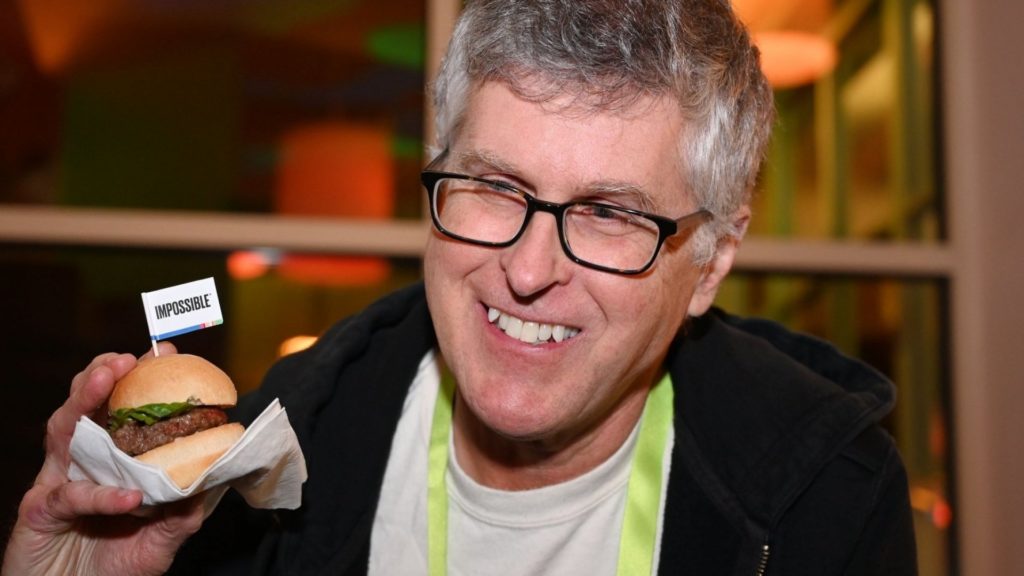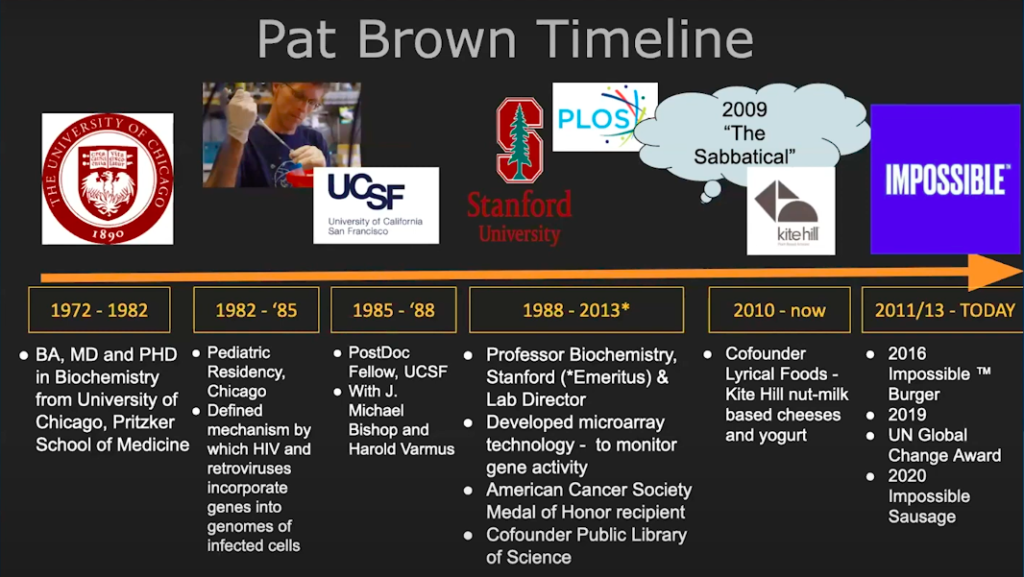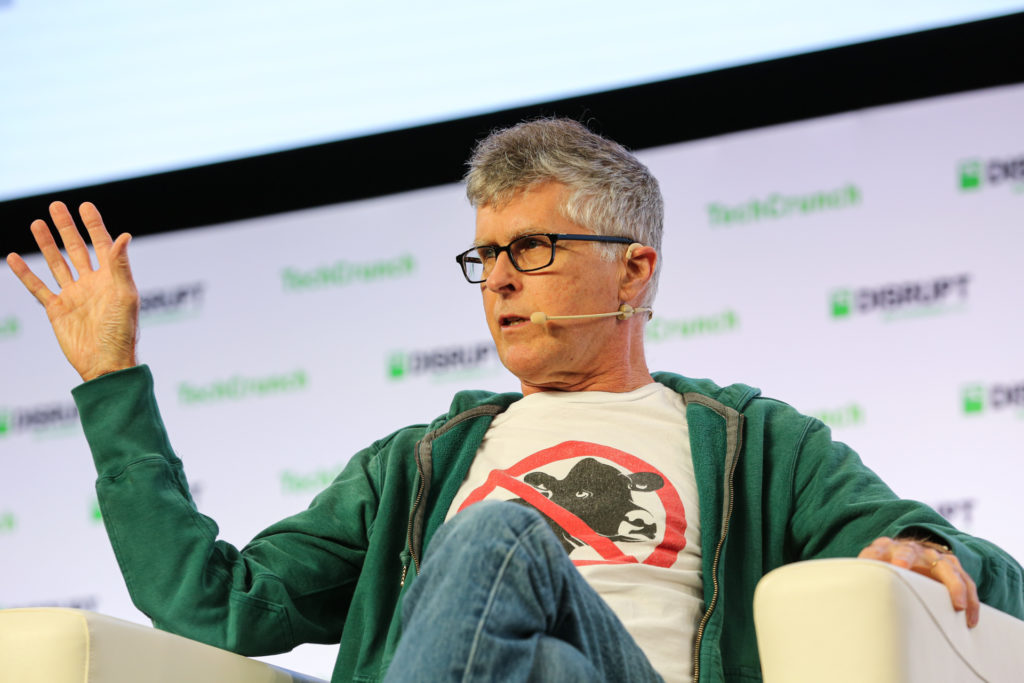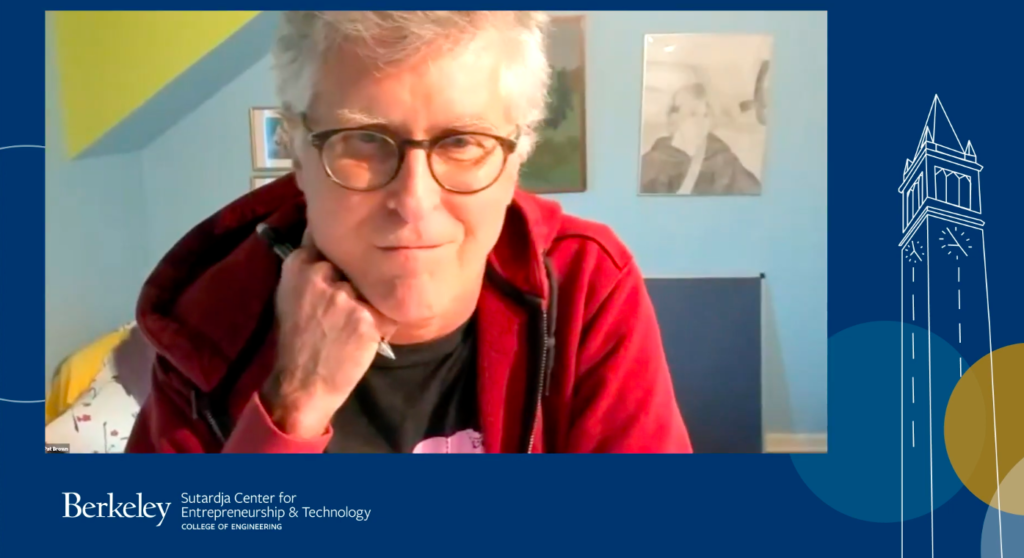
In SCET’s Newton Lecture Series fireside chat, Dr. Pat Brown narrates the story of Impossible Foods, tying his professional journey into a narrative of his determination to solve the most challenging problems and the quest to follow his curiosity.
Dr. Patrick O. Brown is the founder of Impossible Foods, a producer of plant-based meats, fish, and dairy, along with being the co-founder of Lyrical Foods (aka Kite Hill Foods), a producer of plant-based alternatives such as yogurts, cheeses, dips, and many more. With millions around the world recognizing alternative meat to be the future of food production and consumption, Pat Brown’s vision for plant-based foods is hailed by millions around the world. An academic with an extensive background in biochemistry and medicine, Pat Brown is seen as a revolutionary in the eyes of many. Yet, that is not all; Pat Brown is also the co-founder of the Public Library of Science, a nonprofit open-access science, technology, and medicine publisher and library of scientific journals and literature.
A scientist, inventor, social entrepreneur, and visionary, the 350+ virtual Cal student audience welcomed Dr. Brown In a special talk given at the Sutardja Center for Entrepreneurship and Technology’s 2021 A. Richard Newton Lecture Series.
The Journey of Dr. Pat Brown
Beginning his story with a snapshot of his timeline, Dr. Pat Brown described his education and residency in pediatrics at the University of Chicago. The experience of observing children with untreatable ailments motivated him to pursue research to better understand diseases and how to treat them. His last year of residency, in happenstance, coincided with the first year of the HIV epidemic, which kickstarted his research efforts in understanding how these retroviral infections replicate in the first place. This journey led him from the University of Chicago’s Pritzker School of Medicine to UCSF, which further spawned his research journey and professorship at Stanford University.

Jumping into a quick biology lesson, Dr. Brown explained how “in every cell in our body, we have the same genome.” A genome is the complete set of genes or genetic material present in a cell or organism. “In each cell, the genome is writing a different script for the life history of that cell. These scripts are rewritten hour-by-hour as development occurs or as you experience different situations (such as infections and so forth)”, he continued.
Having a strong hunch that genome sequencing was “around the corner,” Dr. Brown decided to try building a tool that utilizes this sequence information to read the scripts that the genome was writing for each cell and condition (called a DNA microarray). This, for the first time, allowed him to quantitatively measure the expression of every gene in the genome and create an interpretive framework that helped scientists profile genome expressions and really give meaning to understand the gene expression patterns in living cells.
“As a researcher, my professional responsibility was to follow my curiosity.”
Dr. Pat Brown described his research position at Stanford as “the perfect job.” He further explained, “as a researcher, my professional responsibility was to follow my curiosity,” which allowed him to dive deeper into his research, working day-in and day-out on addressing some of the most challenging problems in the world of genetics and biochemistry.
When he received a sabbatical from his job at Stanford, Dr. Brown immediately began using his free time to figure out what was the most important problem in the world that he could potentially contribute to solving. He very quickly zeroed in on recognizing the most destructive technology in human history – animal agriculture – that transforms animals into meat, fish, and dairy food. Now that he had identified a problem, the next thing he tried to brainstorm was how could he solve this problem. His experience at the Paris climate conference made him realize that this could neither be solved by regulation nor could it be solved by education – not only was he the only person in the conference who was talking about the greenhouse effect of farming animals for food, but also because he observed how everybody at the conference went out later that night and ate steak for dinner. He knew these were some of the most sincerely committed environmentalists on the planet – they knew the problem, and they cared about it. Yet, it was too hard to give up on foods they loved, no matter what the motivation was.
This moment made Dr. Brown realize the approach he needed to take to rectify this problem – he described this as being “a technology-based problem that required a market-based solution.”
He took a moment to explain what he had meant about producing foods using animals being a “technology-based problem”. Dr. Brown believed that humans were using the wrong technology to produce animal-based foods because it is an incredibly underperforming and inefficient technology platform in both resource and economic terms. Dr. Brown then explained what he meant about the problem requiring a “market-based solution” – the way one can eliminate animal-based food production, the most destructive technology on earth, is by competing against it successfully in the market. This, in his opinion, could only be done by developing a better technology platform for producing all the foods whose consumption is supporting the most destructive industry on Earth, while simultaneously competing against traditional foods by making innovative foods that do a better job of delivering everything consumers value – the most important and difficult one being deliciousness, but also nutritional value, healthfulness, affordability, and so forth.
When one thinks of the solution as being technological in nature for transforming plants into similar foods, it starts to seem obvious that the properties consumers value in animal-based foods are just emergent properties of a particular assembly of biomolecules, proteins, and fats. Thus, once humans can understand the underlying molecular mechanisms of ‘deliciousness’ in animal meat, then we can not only match but also exceed across properties that consumers value from animals.
“A cow didn’t evolve to be delicious,” Dr. Brown stated. “It was unfortunate that it was delicious at a time when people decided to domesticate it, even when making meat was incredibly inefficient and fundamentally unimprovable.”

With technological innovation, stepping away from the source has always led to transformational shifts in industries. Dr. Brown cited the example when humans stepped away from the horse as a power train for transportation more than 100 years ago, and the advancement in technology immediately accelerated as people worked to continuously improve the different versions of automotive engines. Keeping this anecdote in mind, along with his resolve to solve the most important problem in the world, Dr. Brown set an ambitious goal for himself and his team – to sweepingly replace the old technology used for animal-based food production with new technology by 2035, slightly more than a decade. Thus began the birth of Dr. Brown’s idea for creating plant-based foods – the science behind the monumental success of Impossible Foods and Lyrical Foods.
Pat Brown’s Advice for Students
When asked about his advice for the skills should equip themselves with for the future, Dr. Brown’s answer was simple:
“The most important skill is the determination to solve a problem.”
Pat Brown went on to explain what he meant, “There are a lot of people who could have done the same level of problem-solving as I have. The reason I succeeded is that nobody else decided to do it, and I think that’s something important for students to understand. There are all kinds of problems out there waiting to be solved. The critical thing is not about whether you are an expert in a field or not, because expertise can be learned; it is to realize that I can take this on, and I am willing to take this on, even if that means failing at it.”
In general, the skill that makes you a successful scientist is not field expertise; it is the ability to break down a problem, figure out a strategy for solving it, and then have the determination to see it through.
What Sparked the Existence of Impossible Foods
Pat Brown then spoke about the existence and success of Impossible Foods, “You can’t name a field of science that wasn’t particularly important to the existence of Impossible Foods.”
The scientists he worked with, all of them determined to solve the animal-based food production problem, started with studying biochemical systems to understand what properties of meat make them valuable to consumers. They began learning about food and food systems, followed by understanding how to create a sustainable, scalable food solution from plant extracts that match the specific kinds of biochemical, biophysical specifications that are required to produce the textural property, juiciness, cooking behavior, flavor chemistry, and so forth for animal-based foods. The answer turned out to be very simple – their research pointed to the molecule heme, which is the molecule that makes our blood red, carries oxygen in our blood, and is also essential for every living cell because it is part of the way cells generate energy. Heme, aside from being oxygen carriers, is one of the most potent catalysts in nature. Hence, when they discovered heme is much more abundant in animal tissues than in-kind tissues for physiological reasons, Dr. Brown and the scientists realized it is the abundance of heme that makes meat flavor and aroma categorically different from anything belonging to the plant world.

As Dr. Brown reflected on this discovery, he remarked that anyone could have made a similar finding a hundred years ago, but nobody asked the question he did. “People thought meat is just meat, and it is what it is, and it is not a scientific question, but it is.”
People didn’t think to ask questions about how and why particular food tasted or smelled a certain way, and that is why it took so long for anyone to realize what heme meant for food systems. Dr. Brown believes there is a multitude of questions that people haven’t even considered asking over centuries, and that it “can similarly be extrapolated to all kinds of foods and other systems that people just take it to be the way it is but in reality could be vastly improved.”
Q&A from Students
How do you think the variety and possibly the competition of other plant-based companies affect the overall growth of the industry? How does that affect the aim which is to help the environment and reduce animal agriculture?
I feel awesome! It is great. A lot of people think, “Oh, we [Impossible Foods] are worried about the competition”, but absolutely not. From a mission standpoint, the best thing that could happen is for those companies to be successful in making products that current consumers are happy to choose. My own opinion right now is that, in general, their products kind of suck from the perspective of meat consumers. However, that’s not for me to decide because I haven’t eaten meat from animals for 50 years. But if they keep getting better at making products that are more appealing to the consumers, I will be their biggest fan because the task we’re taking on is as a mission-based company. If it turned out that we have to share the market with 50 other companies…well, it’s a $3 trillion global market so we have nothing to complain about from a business standpoint! It is a misunderstanding about the whole industry because the only competition we care about is the cow. We have to be better than the cow in every way that matters to meat lovers in order to win, and that’s what we focus on.
You are a person of science and you are also the founder of the Public Library of Science; you are for the spread of free information. I was wondering if Impossible would ever consider making their proprietary food production open-sourced to accelerate the market in terms of producing and taking over the global animal-based meat industry.
Absolutely, we would consider that. We have actually thought about ways of doing that to accelerate our growth. Right now, the reason we have not done so is that no-one else is pushing this [plant-based meat] as hard as we are, and in order for us to be able to sustain our growth, we need to be able to raise money from investors. If you know anything about investors, it matters a lot to them that you have intellectual property. I’ve always been a proponent for sharing knowledge as freely as possible, but in this case, the trade-off is if we did that we’d have a much harder time raising money. Nobody else is close to where we are in terms of being able to get this job done, which does set back the whole mission. But when we get to a point where I feel like we have become pretty self-sufficient financially, then I think that could be a real accelerator of our mission to give free licenses or very cheap licenses to other people who would then use that technology to amplify the impact. But we still have a ton of stuff we need to do that costs money to get to that point of no return.
What are your words of advice to your past self sitting in your graduate or undergraduate school classrooms and laboratories?
I would say life is too short to not do things that matter to you and matter to the world. For me, there’s nothing more rewarding than to have a really hard challenge to work on, and this is at least true for most people. I like a hard challenge, even if it is a crossword puzzle, but a hard challenge that really means something to the world…that’s precious. That is what I would say to myself, but that is what I always believed anyway. Also, I would say to not be discouraged. You’re gonna have lots of times when someone slaps you down for one reason or another, but just always remember to stand back up.
Another thing: don’t be afraid of failure. The worst thing that will cause people to not be successful scientists, or not be successful in doing meaningful things, is if they are always trying to avoid failure instead of trying to accomplish something. It is surprising how many people have this as their phenotype. There’s this thing I called the ‘Harvard Syndrome’ – people have been trained their entire life to get an A+ to the point where they’re deadly afraid of getting a B. I just know people like that when they come into the laboratory, where they spend months poking around but not contributing to anything meaningful because they are afraid to do experiments and watch it fail; it is a blow to their ego. Something I’m most proud of are ideas that I’ve had that were wrong, ideas that I’ve pursued at a considerable expense and time only to be proven wrong. But you know what? You have to do that, because only then can you make the impossible possible. And that’s what I’m most proud of.
This lecture was part of the A. Richard Newton Lecture Series: A Berkeley Changemaker™ course. Students interested in taking the course can find more information here.
